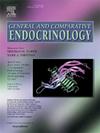鱼脑和脑垂体中促性腺激素抑制激素细胞和纤维的个体发育
IF 1.7
3区 医学
Q3 ENDOCRINOLOGY & METABOLISM
引用次数: 0
摘要
促性腺激素抑制激素是一种神经肽,属于rf -酰胺家族的肽,首次在鸟类中被发现。这种肽可以抑制鸟类和哺乳动物促性腺激素的合成和释放。虽然在不同的鱼类中也检测到促性腺激素抑制激素(Gnih)变异,但其生理作用的知识仍然是不确定和有争议的。此外,关于Gnih细胞早期神经元发育的信息很少。在此背景下,本研究的目的是表征成年鱼和bonariensis (Odontesthes bonariensis)早期发育过程中大脑和垂体中含有gnh的神经元和纤维,以及它们与性别分化过程的可能关系。采用免疫组化方法,用不同抗血清对成年大鼠脑Gnih神经元和纤维进行了检测。在嗅球、末梢神经节、脑端腹侧外侧核、脑室后周核、背被中可见Gnih-ir免疫反应神经元,在次级味觉核中可见部分孤立的神经元体。脑下垂体的gnh -ir神经纤维分布较少。从孵化到第10周,研究Gnih神经元和纤维的分布,包括性别分化期,直到观察性腺性别。从末梢神经节和间脑后室周核中孵化出gnh免疫反应性神经元体。在包括视网膜在内的许多区域均可见gnh -ir纤维,在垂体中可见丰富的神经支配。从孵化后第一周开始,在中脑背被和端脑腹侧外侧核中发现了gnh -ir神经元体。此外,垂体中检测到Gnih-ir细胞。这些gnh -ir细胞在孵化后3至7周持续检测到,与性腺分化的开始一致。在第10周和成人中,仅在垂体中观察到少量gnh -ir纤维。虽然这些垂体Gnih-ir细胞的确切功能尚不清楚,但这些细胞的出现与性别分化过程之间的关系表明,Gnih可能影响这一过程。本文章由计算机程序翻译,如有差异,请以英文原文为准。
Ontogeny of gonadotropin-inhibitory hormone cells and fibers in the brain and pituitary gland of the pejerrey fish, Odontesthes bonariensis
The gonadotropin-inhibitory hormone is a neuropeptide belonging to the RF-amide family of peptides, first characterized in birds. This peptide can inhibit the synthesis and release of gonadotropins in both avians and mammals. Although gonadotropin-inhibitory hormone (Gnih) variants have also been detected in different fish species, knowledge of their physiological action is still inconclusive and controversial. In addition, there is very little information on the neuronal development of Gnih cells in early stages. In this context, the objective of the present study is to characterize Gnih-containing neurons and fibers in the brain and pituitary gland of adult fish, and during early development of the pejerrey (Odontesthes bonariensis), and the possible relationship with the sex differentiation process.
The Gnih neurons and fibers were determined by immunohistochemistry by using different antisera in the adult pejerrey brain. Gnih-immunoreactive (Gnih-ir) neurons were observed in the olfactory bulbs, the terminal nerve ganglion, the lateral nuclei of the ventral telencephalon, the posterior periventricular nucleus, the dorsal tegmentum, and some isolated neuronal bodies were detected in the secondary gustatory nucleus. Very few Gnih-ir fibers were detected innervating the pituitary gland.
The Gnih neuronal and fiber distribution was also studied from hatching to week 10, covering the sex differentiation period until the gonadal sex was observed. Gnih-immunoreactive neuronal bodies were identified from hatching in the terminal nerve ganglion and the diencephalic posterior periventricular nucleus. Gnih-ir fibers were observed in many regions, including the retina, and a profuse innervation was observed in the pituitary. From the first week post-hatching, Gnih-ir neuronal bodies were identified in the dorsal mesencephalic tegmentum and the lateral nucleus of the ventral telencephalon. In addition, Gnih-ir cells were detected in the pituitary. These Gnih-ir cells were consistently detected from 3 to 7 weeks after hatching, coinciding with onset of gonadal differentiation. At week 10 and in the adult, only a few Gnih-ir fibers were observed in the pituitary. Although the precise function of these pituitary Gnih-ir cells is unknown, the relationship between the appearance of these cells and the process of sex differentiation suggests that Gnih may influence this process.
求助全文
通过发布文献求助,成功后即可免费获取论文全文。
去求助
来源期刊

General and comparative endocrinology
医学-内分泌学与代谢
CiteScore
5.60
自引率
7.40%
发文量
120
审稿时长
2 months
期刊介绍:
General and Comparative Endocrinology publishes articles concerned with the many complexities of vertebrate and invertebrate endocrine systems at the sub-molecular, molecular, cellular and organismal levels of analysis.
 求助内容:
求助内容: 应助结果提醒方式:
应助结果提醒方式:


